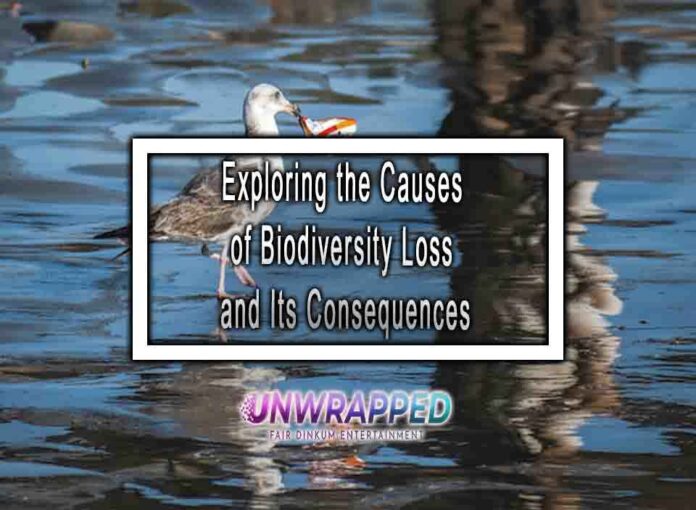Biodiversity loss is a significant global challenge that results from a complex interplay of various natural and anthropogenic factors. Understanding the causes and consequences of biodiversity loss is crucial for developing effective conservation strategies. Here are key factors contributing to biodiversity loss and their consequences:
Causes of Biodiversity Loss:
- Habitat Destruction and Fragmentation:
- Cause: Urbanization, agriculture, logging, and infrastructure development often lead to the destruction and fragmentation of natural habitats.
- Consequence: Loss of habitat reduces the available living space for species, disrupts ecological processes, and isolates populations, making it difficult for species to survive and reproduce.

- Climate Change:
- Cause: Human activities, such as the burning of fossil fuels, deforestation, and industrial processes, contribute to the accumulation of greenhouse gases, resulting in global warming and climate change.
- Consequence: Changes in temperature and precipitation patterns can alter ecosystems, disrupt migration patterns, and affect the distribution of species, leading to habitat loss and increased vulnerability.
- Overexploitation of Species:
- Cause: Unsustainable harvesting of species for food, medicine, pets, and ornamental purposes, as well as overfishing and illegal wildlife trade.
- Consequence: Declines in population sizes, depletion of natural resources, and disruptions in food chains, leading to ecological imbalances.
- Pollution:
- Cause: Industrial, agricultural, and domestic activities release pollutants such as chemicals, pesticides, and waste into air, water, and soil.
- Consequence: Pollution can harm ecosystems, contaminate water sources, poison species, and disrupt the reproductive capabilities of many organisms.
- Invasive Species:
- Cause: Human introduction of non-native species into new environments, intentionally or unintentionally.
- Consequence: Invasive species can outcompete native species for resources, introduce new diseases, and disrupt ecological interactions, leading to declines or extinctions of native flora and fauna.
- Disease:
- Cause: Spread of diseases among wildlife populations, often facilitated by human activities, such as habitat disturbance and the global movement of species.
- Consequence: Disease outbreaks can lead to population declines and contribute to the decline of vulnerable species.
- Land Use Change:
- Cause: Transformation of natural landscapes into agricultural land, urban areas, or other forms of land use.
- Consequence: Altered land use patterns reduce the availability of suitable habitats for many species, leading to population declines and local extinctions.
- Lack of Conservation Measures:
- Cause: Insufficient conservation efforts, inadequate protection of natural areas, and weak enforcement of environmental regulations.
- Consequence: Without effective conservation measures, species are left vulnerable to the various threats they face, contributing to declines and extinctions.
Consequences of Biodiversity Loss:
- Ecosystem Instability:
- Consequence: Reduced biodiversity can lead to ecosystem instability, making ecosystems more vulnerable to disturbances and less resilient to environmental changes.
- Impacts on Human Well-being:
- Consequence: Loss of biodiversity can affect human well-being by reducing ecosystem services, such as clean water, pollination of crops, and disease regulation.
- Economic Losses:
- Consequence: Biodiversity loss can result in economic losses, especially for communities dependent on natural resources for livelihoods, agriculture, and tourism.
- Cultural and Aesthetic Impacts:
- Consequence: Biodiversity loss can erode cultural traditions, reduce aesthetic value, and limit recreational opportunities linked to natural ecosystems.
- Disruption of Food Chains and Webs:
- Consequence: Biodiversity loss disrupts food chains and webs, affecting predator-prey interactions and the overall functioning of ecosystems.
- Loss of Genetic Diversity:
- Consequence: Reduced genetic diversity within species diminishes their adaptive capacity, making them more vulnerable to diseases and environmental changes.
- Potential for Ecosystem Collapse:
- Consequence: If biodiversity loss continues, ecosystems may reach a point where they cannot function effectively, leading to potential collapses with cascading impacts on other ecosystems and human societies.
- Impact on Medicine and Biotechnology:
- Consequence: Biodiversity loss limits the pool of species available for potential medicinal discoveries and biotechnological innovations.
Addressing biodiversity loss requires a multifaceted approach, including habitat conservation, sustainable resource management, climate change mitigation, and international cooperation. Efforts to protect biodiversity are essential for maintaining the health of ecosystems, promoting human well-being, and preserving the incredible diversity of life on Earth.











